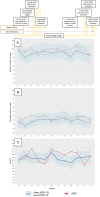Stroke Care Pathway ensures high-quality stroke management in the COVID-19 pandemic
- PMID: 37019970
- PMCID: PMC10075157
- DOI: 10.1038/s41598-023-32586-5
Stroke Care Pathway ensures high-quality stroke management in the COVID-19 pandemic
Abstract
The aim of our study was to assess whether a well-established federal state-wide Stroke Care Pathway delivering high quality stroke care can cope with the COVID-19 pandemic and associated measures to contain the virus spread. The retrospective analysis is based on a prospective, quality-controlled, population-based registry of all stroke patients in the Tyrol, a federal state of Austria and one of the early hot-spots of COVID-19 in Europe. Patient characteristics, pre-hospital management, intra-hospital management and post-hospital were analysed. All residents of the Tyrol suffering ischemic stroke in 2020 (n = 1160) and four pre-COVID-19 years (n = 4321) were evaluated. In 2020, the annual number of stroke patients was the highest in this population-based registry. When local hospitals were overwhelmed with SARS-CoV-2-patients, stroke subjects were temporarily allocated to the comprehensive stroke centre. Stroke severity, quality metrics of stroke management, serious complications, and post-stroke mortality did not differ between 2020 and the four comparator years. Notably, iv. thrombolysis-rate was similar (19.9% versus 17.4%, P = 0.25) and endovascular stroke treatment even better (5.9% versus 3.9%, P = 0.003) but resources for in-patient rehabilitation were limited (25.8% versus 29.8%, P = 0.009). Concluding, a well-established Stroke Care Pathway was able to maintain high-quality acute stroke care even when challenged by a global pandemic.
© 2023. The Author(s).
Conflict of interest statement
The authors declare no competing interests.
Figures
References
MeSH terms
LinkOut - more resources
Full Text Sources
Medical
Miscellaneous


